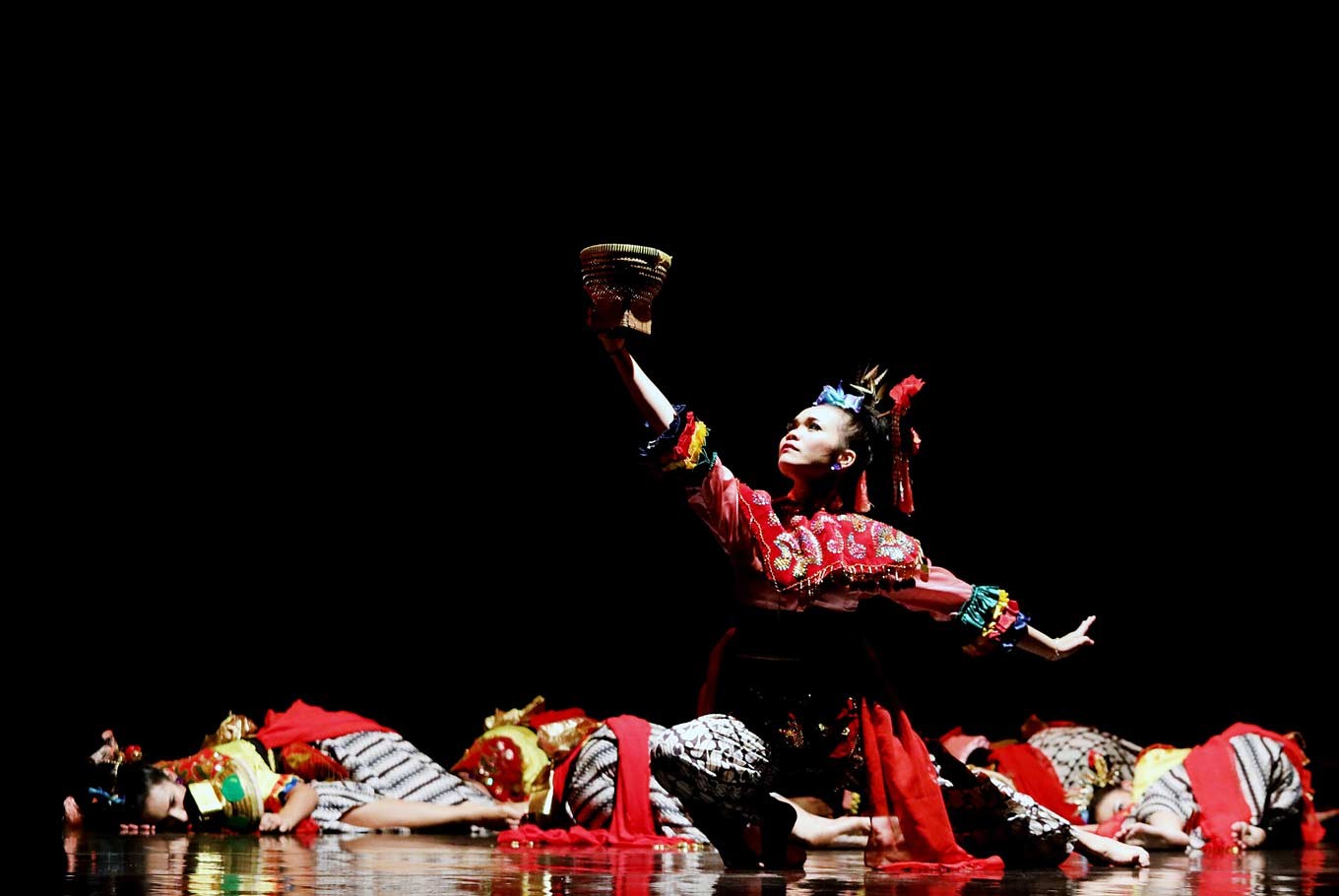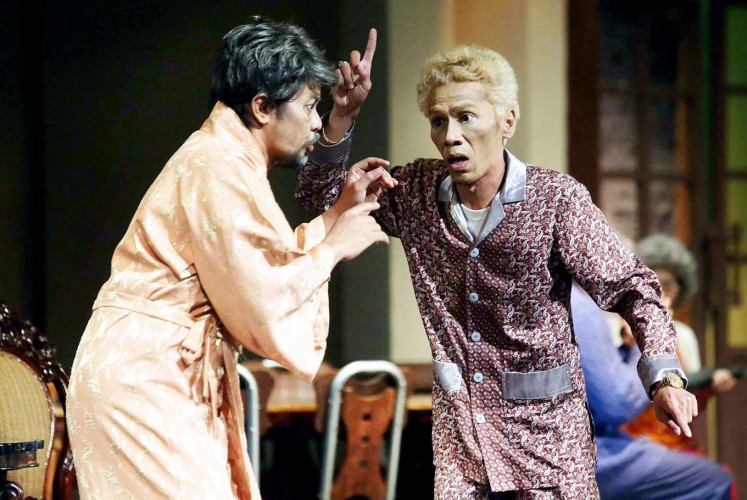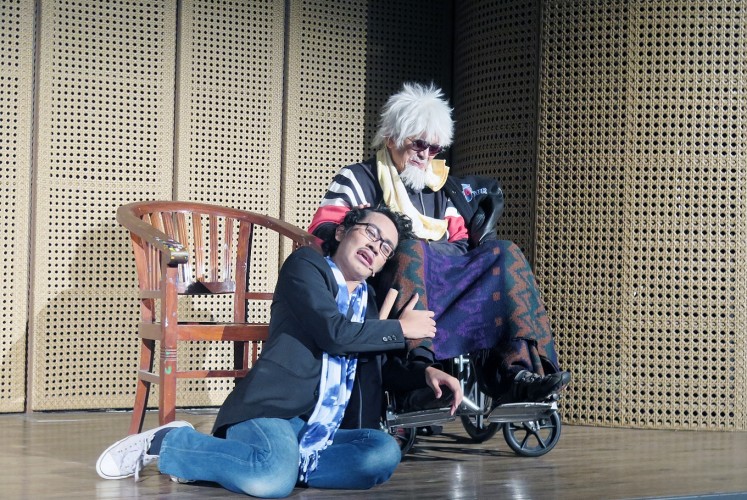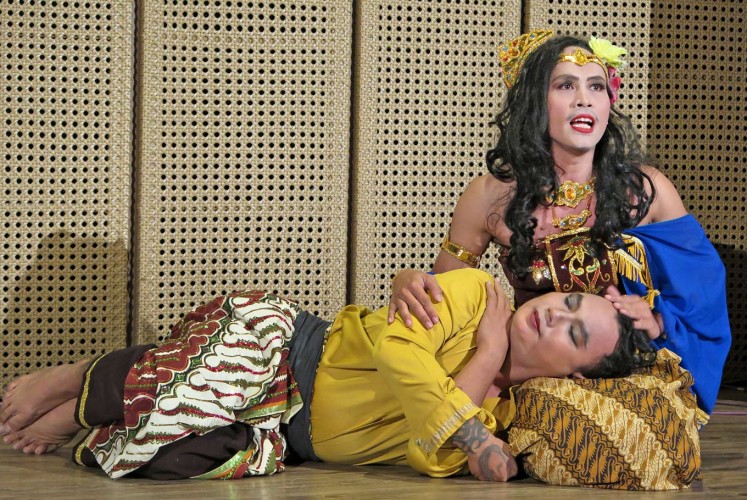Popular Reads
Top Results
Can't find what you're looking for?
View all search resultsPopular Reads
Top Results
Can't find what you're looking for?
View all search results2017 A colorful year for performing arts
Change text size
Gift Premium Articles
to Anyone
L
ooking back, the last year has presented us with a great variety of genres and stories to tell on the stage, leaving audiences not only entertained but also enlightened.
This was a year in which many people wanted to escape from the mundanity of daily life and social media posts, which are often dominated by hate speech, emotional debates over the old and new Jakarta Governor and silly corruption cases. This is why we need to go to the playhouses to free ourselves from reality, at least for a few hours
PLAY PERFORMANCES
Theaters can serve as a way to heal a broken heart and come to terms with traumatic experiences, as proven by the latest show entitled Ode Tusuk Konde (Ode to a Hairpin) which voiced the pain and struggles of survivors of sexual abuse and violence.
Read also: Stories of survivors bring audience to tears, awareness
This year we have also seen some theatrical troupes that, despite all their challenges, have continued to show their prowess on the stage.
Highlights from the playacting scene this year come from the shows of the country’s legendary theater troupes such as Teater Koma, Teater Mandiri and Miss Tjitjih. They deserve praise for their existence and perseverance to maintain and grow their fan base despite all of the difficulties in drawing new audiences.
In its 40th year, Teater Koma proves it is still going strong by performing big play productions regularly every year. Mainly supported by Djarum Bakti Budaya, the troupe presented three main shows this year. The first, titled Opera Ikan Asin (Salted Fish Opera) ran during their anniversary month of March at Ciputra Artpreneur in South Jakarta, followed by Warisan (Legacy) in Gedung Kesenian Jakarta art playhouse in Central Jakarta in August, and finally the fourth installment of Chinese folk tale Sie Jin Kwie in Graha Bhakti Budaya in Taman Ismail Marzuki (TIM), Central Jakarta in November.
Reach out: A group of dancers from the Sanggar Tari Paduraksa Tebet dance academy wear traditional Betawi attire as they perform at the third annual Jakarta Dance Meet Up in October. (DKJ/File)Teater Koma has also sent a small group of its members to perform regularly during a program called Akhir Pekan @Museum Nasional (Weekend at the National Museum) held at the Indonesia National Museum over the past five years. The theatrical shows, which aim to get young visitors interested in the country’s precious artifacts, have grown into a highly anticipated event that draws bigger young audiences each year.
Actor Rangga Riantiarno, who played Si Jin Kwie, said the troupe’s main reflections this year were regeneration and how to prepare its members for future challenges. Rangga said the youngest members of the troupe were senior high school students who just joined the group for one to two years.
“I realize that we have to look for a meeting point between maintaining the artistic values of Teater Koma and the millennials’ taste. The increasing number of youngsters in both the troupe and in the audiences hopefully can help take us in that direction,” he told The Jakarta Post over text messages.
The troupe also tries to reach out to a wider audience by using social media such as Facebook, YouTube and Instagram, opening themselves up to feedback from the public. Rangga said there were many young people sending direct messages to the group’s official Instagram account, but the most frequently asked question was about admission fees.
“I am afraid they think that this is a kind of acting course. The thing is, the process to put on a big scale show requires details and cannot be instant,” he said, adding that those who stay are the ones who really love the theater world.
Rangga said theater groups in the country had been alone in their struggle to stay in existence since the Old Order, as they barely got attention from the government. His only hope is to see an increasing number of playhouses that can accommodate theater shows in the coming years.
This year also witnessed the passionate dedication of award-winning artist and writer Putu Wijaya, who founded Teater Mandiri in 1971. Despite being unable to move half of his body after suffering from a stroke, Putu directed his monologue titled Oh in Galeri Indonesia Kaya auditorium in February, where he cast his only son Taksu Wijaya as the main character for the first time.
Putu said the monologue served as a reminder that people must be careful when analyzing statements from politicians and corporate officials, who often have their own hidden agendas.
“Indonesian people must be very critical. Even smart people can be fooled,” he said.
Special attention should be paid to Miss Tjitjih, a legendary Sundanese theater group that will turn 90 next year.
Read also: Miss Tjitjih survives to keep Sundanese culture alive
Starting this year, the group, which consists of nearly 100 members, will no longer perform in its home, the Miss Tjitjih Theater in Cempaka Putih, Central Jakarta, due to financial difficulties. This year was the hardest for them, remembering that last year alone, they staged 24 shows in their theater building.
Troupe director Imas Darsih said they would perform on invitation, including invitations to perform at various events such as wedding ceremonies, circumcision rituals and public events. Miss Tjitjih relies on subsidies from the Jakarta administration to perform, but troupe director Imas Darsih said they did not get any funding this year.
Like Teater Koma, the group also tries to use social media to promote their events and tap into a younger audience. They also cooperate with public figures as seen in their show in May when they collaborated with the 2011 winner of the Putri Indonesia pageant, Maria Selena to stage Sangkuriang, the most popular folktale in West Java, in Galeri Indonesia Kaya.
Winning the millennials’ attention is an ongoing battle for Miss Tjitjih, but the members are determined to continue their parents’ legacy. For Miss Tjitjih, the show must go on.
Father and son: Playright Putu Wijaya (right) performs with his son, Taksu Wijaya, in the Oh stage play. (JP/A. Kurniawan Ulung)DANCE
The rise of dance communities is a sign that residents of this country are not going to stop expressing themselves through the universal language of dancing. Dancing is not only an ancient tribal activity or part of rituals and celebrations. It is now a source of collective pride for each community, in which the members devote their time to grow with the dance itself.
This year saw remarkable shows by Eki Dance Company, the showcase of Indonesia’s diversity by dance academy Indonesian Dance Theater, the persistence of Sanggar Tari Padnecwara in promoting classic Javanese dance and the colorful shows of the various dance groups of Jakarta Dance Meet Up (JDMU), a platform provided by the Jakarta Arts Council (DKJ).
Another highlight in the dancing scene this year was the increased representation of the diffable (different ability) community at dance events. Indonesian Ballet Gala in September, for example, celebrated an inclusive dance event where diffable and non-diffable dancers from Indonesia and other countries shared the stage.
Read also: Acknowledging millennials in EKI Update 3.0
Fresh twist: The popular Sundanese folktale Sangkuriang is given unexpected twists by the Miss Tjitjih theater group. (JP/A. Kurniawan Ulung)“The dance scene in 2017 is quite vibrant with the appearance of young choreographers and diverse genres ranging from traditional dances to ballet and street dance like hip-hop. Such variety makes the stage attractive,” DKJ Dance Committee chairwoman Hartati told the Post.
She said the strength of this year’s dance performances lied in the strong base of community dances.
“Padnecwara, for example, has been around for decades, over 40 years I think. Their consistency in preserving classic Javanese dance is very important. Such communities are getting stronger now and they need room for expression,” she said, adding that some communities do not have enough budget to perform or need to chip in themselves to rent a place to practice.
Hartati said this momentum should be seized and she hoped that performance venues like TIM would be better managed. She said under the new policy from the city administration, rental fees for the auditoriums and theaters in TIM are dropping significantly, but artists are not given priority to book them, so the facilities are booked for private events.
“When it is used for private events such as school art events, the public cannot enjoy it,” she said.
The dance communities, she said, still faced the same old problem, which was to grow audiences.
“That is why in JDMU, we invite various communities so their fans can mingle and watch other genres outside their favorites. When we give birth to new artists, we need to build the audience at the same time.
Roll with it: Performers from the Jakarta Disabled Children's Foundation (YPAC) join forces with EKI Dance Company for a powerful performance. (JP/Rifky Dewandaru)















